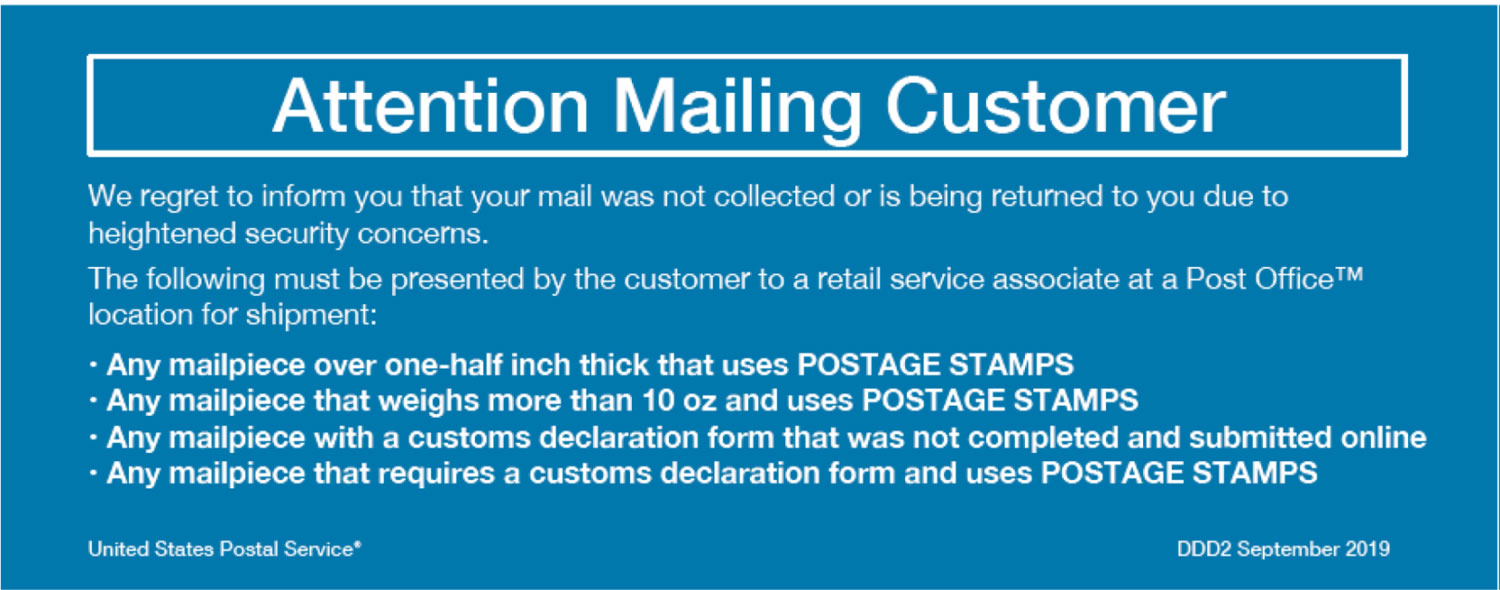What Can I Put in a Usps Blue Box
Remember the US Postal Service's "if it fits, it ships!" advertising campaign?
Not anymore.
In direct response to recent mail-borne threats, the USPS has reduced the acceptable size of mail accepted at collection bins.
The size change is intended to reduce threats from packages from unknown (and therefore possibly nefarious) chains of custody.
The details: New USPS size restrictions
Previously accepted sizes, approximately 4x8x12" are now reduced to 1/8 the size—down to ½ inch thick.
The maximum allowable weight is now only 10 ounces, roughly 25% less than in previously accepted mail.
| Old | New | Change | |
| Dimensions | 4″ x 8″ x 12″ | 0.5″ x 8″ x 12″ | Depth ↓ 75% |
| Weight | 14 oz | 10 oz | Weight ↓ 28.5% |
What to expect
According to the new requirements,
"Customers who need to mail packages with postage stamps that are larger than one-half inch thick or heavier than 10 ounces must conduct the transaction in person at a Post Office retail counter."
This directive was sent out in a postal bulletin, to employees, by the USPS without advertising to the public:
"Effective October 1, 2019, mail pieces bearing stamps for postage that are more than one-half inch thick or weigh more than 10 ounces will be prohibited from entering the mail stream through collection boxes, building mail chutes, and Post Office mail slots."
What you need to know from the USPS:
- Carriers have been instructed not to accept packages that do not fit the restricted criteria, even in face-to-face transactions (these transactions must occur at a Post Office Retail location).
- Items that cannot be returned immediately are to be isolated and returned to sender via surface transportation only.
Where the new standards apply - Acknowledging that the majority of mail hazards are deposited into the famous USPS blue collection boxes, the new size restriction applies only to parcels deposited in those boxes.
Mail sent from a private mailbox or directly at the Post Office is not subject to these restrictions.
Now what? — Small changes have a major impact.
The new USPS size restrictions block large parcels. That means that many mail items will become smaller and more compact.
As a result, perpetrators will need more packages to move the same amount of contraband.
So, while the gross volume of contraband remains unchanged, the volume of mail will increase dramatically.
This swell in mail volume drives the need for faster, more sophisticated detection capabilities.
Small is the new scary.
Air mail and port/dock shipping container X-ray scanning aren't enough anymore (they never were, really).
X-ray scanning is incredibly powerful and hugely important—but it's not perfect.
That's because X-ray scanners have a massive blind spot:
Small items.
Exactly the dangerous area being enabled by USPS' new size restrictions, and the perfect size for mail threats driven by emotion.
The overall effect is an increased requirement for technology that can detect at lower levels than previously required, the way millimeter wave mail scanners can.
USPS' Message to Consumers
If you try to mail a parcel via collection box, mail chute, or lobby mail slot that exceeds the new size limitations, your parcel will be returned to sender, with this label attached—

Essentially, that message just says "your package is too big for a blue mail box; bring to a Post Office."
What if there is no return address shown?
As part of any mail security SOP, If possible, the Post Office supervisor, manager, or postmaster will contact the addressee (not the sender) by phone.
They'll describe the mailpiece to the addressee, and tell them where it came from (the city and state of the postmark).
But what are the odds of that happening?
If they reach the addressee, the Post Office folks will ask—
- Are you expecting the package?
- If yes, does this mailpiece contain anything liquid, fragile, perishable, or potentially hazardous such as lithium batteries or perfume?
If the addressee is expecting the mailpiece and confirms that it does not contain anything liquid, fragile, perishable, or potentially hazardous, the Post Office staff must:
- Identify the mailpiece via a $0.00 PVI, meter strip, or AVSEC stamp.
- Cancel the postage (if not already canceled).
- Apply Label 127, Surface Transportation Only, and transport the mailpiece via surface transportation only.
On the other hand, if the addressee is not expecting the package, can't confirm its contents, or if USPS staff can't reach them (no phone number identified by directory assistance, phone book, or internet), the Post Office staff must contact the USPS Inspection Service—the USPS' own police force.
—and that means the package will very likely be destroyed.
For more detail, see USPS original source document.
Source: https://raysecur.com/usps-size-restrictions/
0 Response to "What Can I Put in a Usps Blue Box"
Post a Comment